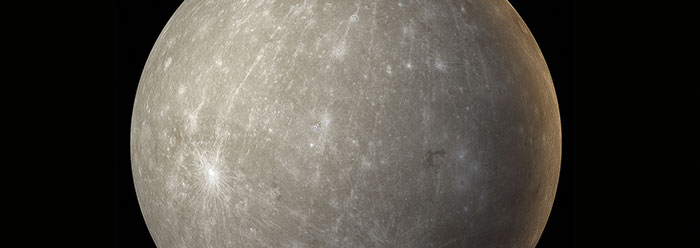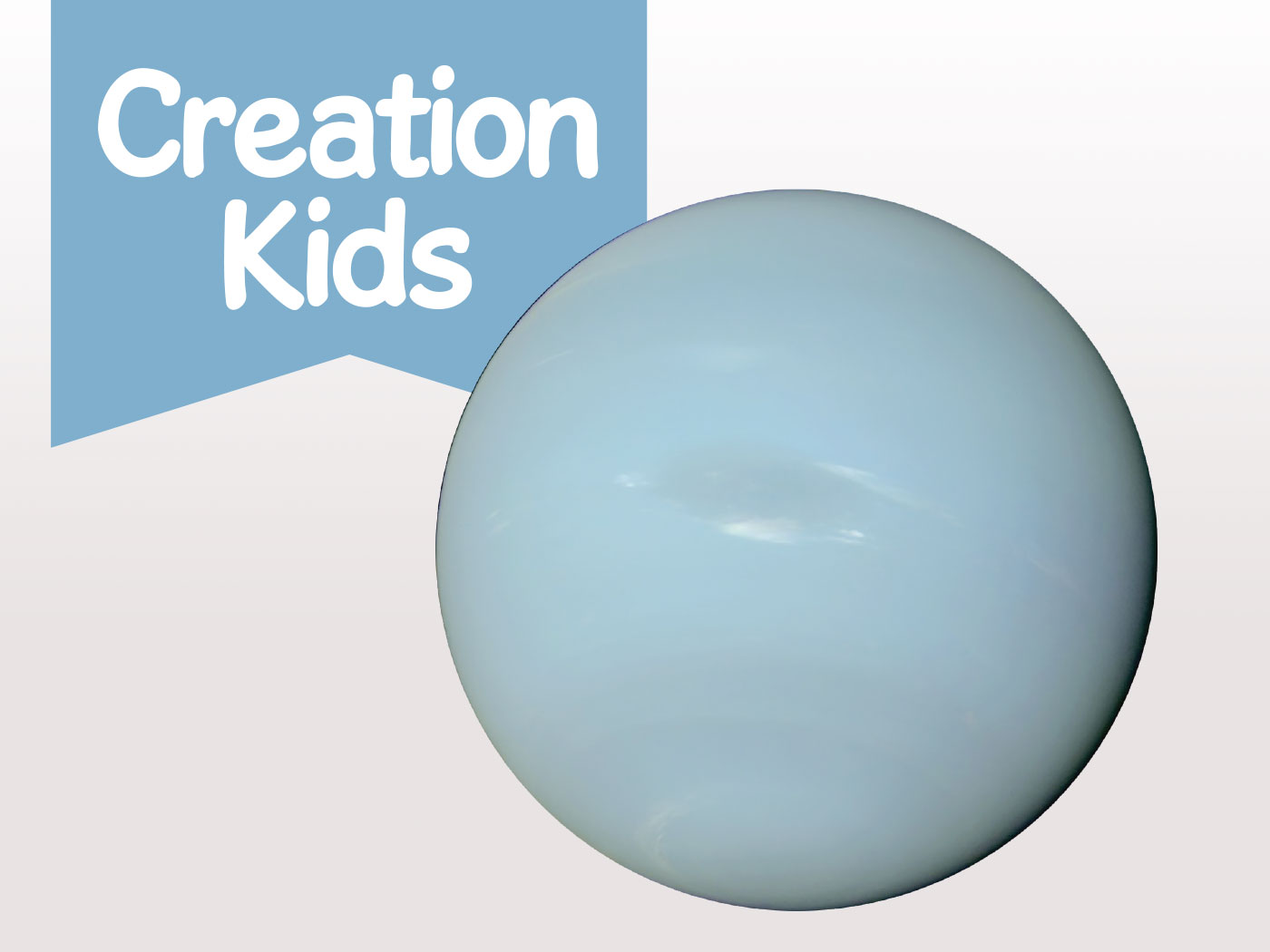The smallest planet of our solar system holds some big mysteries for secular astronomers, and it continues to delight creationists. Mercury is only 38 percent the diameter of Earth, making it the smallest and least massive of the eight planets. It is the innermost planet of the solar system, orbiting the sun at a distance of only 36 million miles. That is nearly three times closer to the sun than Earth is. Mercury is a solid, rocky world, with only a trace of an atmosphere. It has mountains, valleys, plains, and craters—lots and lots of craters! In appearance, Mercury resembles a 40 percent larger (in radius) version of the moon. But when it comes to creation research of the early solar system, Mercury provides many interesting clues. The unusual characteristics of this world make for an intriguing study.
A World of Extremes
Since it is closest to the sun, Mercury has the shortest “year” of any planet, taking only 88 Earth days to complete one orbit. So every time Earth completes one orbit, Mercury has already made four trips around the sun. On the other hand, it has the longest solar day of any planet. A hypothetical observer on Mercury’s surface would only see a sunrise every 176 Earth days!
The “sidereal” (relative to the stars) rotation rate of Mercury is 59 Earth days. If we could somehow watch Mercury through a telescope from a distant star, we would see it rotate one time every 59 days. This is called a “sidereal day” because sidereal means “star,” and we are watching from the stars in this scenario. On the other hand, if we could somehow watch Mercury from the position of the sun, Mercury would appear to turn once every 176 days. This is called a “solar day.” The reason for the difference is that Mercury orbits the sun as it rotates.1 This is also true of the other planets, though the difference is generally much less.2
Mercury’s slow rotation results in some other interesting effects. A given spot on Mercury is in direct sunlight for about 88 continuous Earth days at a time. And since Mercury is three times closer to the sun than Earth is, and since there is no substantial atmosphere to transport the heat, the surface temperature on the day side of Mercury can reach 800 degrees Fahrenheit—more than hot enough to melt lead. Perhaps even more surprising is that the temperature on the night side of Mercury can drop to -280 degrees Fahrenheit! This is because it is in continual darkness for up to 88 days and there is no significant atmosphere to prevent the nighttime surface from radiating virtually all its heat into space.
These extremes lead to some interesting hypothetical scenarios. Suppose your spaceship ran out of fuel, but not before you were able to land near the equator of Mercury. Thankfully, you have landed on the night side (barely), and your spacesuit protects you from the bitter cold surface. But it won’t protect you from the 800-degree daytime temperatures that are about to occur when the sun rises in just a couple of hours! Thanks to Mercury’s very long day, you could begin jogging west at a leisurely pace of two miles per hour. As long as you can maintain that pace, you could stay ahead of the sunrise and remain safely in the night for as long as it takes for the rescue ship to arrive. Effectively, you would be jogging in the opposite direction that the planet rotates, and at about the same rate, thereby permanently remaining in the safe shadow of night.
Mercury’s Strange Orbit
Another curious aspect of Mercury’s rotational (sidereal) period is that it is precisely two thirds of its orbital period. So Mercury turns on its axis three times every time it orbits the sun twice. In astronomy, whenever the ratio of two periods can be expressed by a simple fraction, it is called a “resonance.” Mercury is the only planet in our solar system whose rotation period and orbital period are in resonance. There is a reason for this, and it involves Mercury’s orbit.
Mercury has the most eccentric orbit of any planet—meaning that its orbit is noticeably elliptical and not as circular as the other planets. From Kepler’s Second Law (see “The Solar System” article),3 a planet in an elliptical orbit moves faster when closer to the sun than it does when farther away. The point of closest approach is called perihelion, and this is when Mercury moves the fastest. The most distant point is aphelion, and this is where it orbits the slowest. But Mercury’s rotation rate does not change. Interestingly, when Mercury is near perihelion, its rotation rate essentially matches its revolution rate, such that it keeps the same side pointed at the sun for several weeks.4 This configuration is very gravitationally stable.5
It would be strange to watch this phenomenon from the surface of Mercury itself—if we could somehow survive there. Imagine we begin by watching a very slow sunrise. It takes almost 20 hours between the first moment when the top of the sun peeks over the horizon and the time when the entire sun is visible. The sun seems enormous from Mercury’s perspective—appearing two and a half times larger in the sky than it does on Earth and over six times brighter! The sky remains black even when the sun is up, since Mercury lacks the comfort of Earth’s thick atmosphere. The sun then gradually climbs higher in the sky over the next several weeks. The stars also rise in the east, seeming to move at about twice the speed of the sun. But as Mercury approaches perihelion, the sun seems to gradually slow its upward path, while the stars continue to rise and set at their usual pace. The sun is now noticeably larger than we witnessed at sunrise and over three times larger than it appears from Earth—and ten times brighter! Then the sun gradually comes to a complete stop and begins to travel slowly backward just slightly for about a week. We might feel like Hezekiah (Isaiah 38:8)!6 It then slows to a stop once again and reverses direction once more. The sun then gradually resumes its forward path, shrinking and fading a bit as Mercury moves toward aphelion. The sun eventually sets in the west, roughly three months after sunrise.
Observing Mercury
Since it is so close to the sun, Mercury appears quite bright in our nighttime sky, rivaling the brightest stars. Yet most people have never seen it. The planet can be a challenge to locate because it orbits so close to the sun and is easily lost in the glare. Most other planets can be seen late at night, when the sky is quite dark. But not Mercury—it is only visible at twilight and only at certain times of the year when it is in a part of its orbit that appears (in angle) most distant from the sun. This position is called “greatest elongation.” At such times, it is possible to see Mercury just after sunset for “eastern elongations” or just before sunrise for “western elongations.”7
Thanks to Mercury’s short period, greatest elongations happen six (sometimes seven) times a year. Our next chance to see Mercury will be on October 9, 2013, or a few days before or after this. Go outside 20 to 30 minutes or so after sunset and look low to the west, just above the horizon. Venus will also be visible and bright and much higher in the sky. Look between Venus and the point where the sun sets and you will see the much-fainter Mercury.
Mercury Confirms Creation
Since Mercury is so close to the sun, and only visible low in the sky after sunset or before sunrise, Earth-based telescopic views of Mercury tend to be rather unimpressive and unrevealing. That all changed when NASA sent the Mariner 10 spacecraft to visit Mercury in 1974. During several flyby encounters, Mariner 10 was able to image much of the day side of Mercury in unprecedented detail. It also measured a substantial magnetic field for this tiny planet. This is disturbing news for secularists who believe that our solar system is billions of years old, because a small planet like Mercury should not be able to maintain a magnetic field for so long. But this doesn’t surprise creationists.
Physicist D. Russell Humphreys, Ph.D., has an interesting biblically based model that is able to account for the current strength of planetary magnetic fields based on their true age of about 6,000 years.8 His model lines up quite well with the current measured field strengths of the planets. Dr. Humphreys had also predicted that Mercury’s magnetic field will show measurable decay since the 1974 measurements. And this was confirmed by the more recent (2008-2013) Messenger spacecraft.9
Mercury has also been used to confirm other aspects of science. Theoretical physicist Albert Einstein’s general theory of relativity indicates that gravitational fields affect the measurement of space and time. One such prediction of relativity is that Mercury’s perihelion should “precess” at a different rate than classical physics would predict. “Precess” means that the ellipse of Mercury’s orbit slowly rotates such that the angular location of the perihelion (and aphelion) gradually changes.10 Observations have confirmed Einstein’s prediction, bolstering our confidence in general relativity.
Creationists have long debated when and how the craters we find in our solar system actually happened. Were the planets created with craters? Did God use some process to make the planets on Day Four such that the craters are the last material He brought to impact the surface? Did they happen after the Curse or during the Flood year? And if so, why? Mercury may also hold the key to theories of cratering. Most other rocky worlds in our solar system have tectonic, atmospheric, and volcanic activity that can remove evidence of any previous craters. But not Mercury. Its pristine surface may be a window into the original conditions of our solar system.11 What other secrets can we discern from this fascinating little world? Time will tell.
References
- To make this easier to understand, suppose that Mercury’s rotation and revolution periods were both exactly the same: 88 days. In this case, a person watching from a distant star would see Mercury rotate once in 88 days. But the sun would never see the other side of Mercury because the planet would keep its same “face” pointed toward the sun as it revolves around the sun. Likewise, a person standing on Mercury’s surface would never see a sunrise or sunset, if this were the case. The sidereal day would be 88 days, and the solar day would essentially be infinity.
- Since other planets also orbit the sun, their solar days are also different than their sidereal day. But the difference tends to be much smaller than with Mercury. Earth has only a four-minute difference between its solar and sidereal days. The reason Mercury exhibits such an enormous difference is because the length of its sidereal day is comparable to the length of its year.
- Lisle, J. P. 2013. The Solar System. Acts & Facts. 42 (6): 10-12.
- At the time of perihelion, the orbital angular speed actually slightly exceeds the rotation angular speed for about one week. An observer on the surface would see the sun apparently move slightly backward in the sky for that one week.
- Some orbital resonances are stable and self-correcting, such as Mercury’s. Others are unstable, such that an orbiting body will be continually perturbed until it is ejected into a different orbit altogether. This appears to be the reason why there is a deficit of asteroids having simple resonances with Jupiter’s orbit. These resonance orbits are known as the Kirkwood gaps.
- Critics sometimes declare that God cannot do certain things, such as make the sun go backward as He did for Hezekiah. Such things are simply not possible, we are told. Yet this happens every three months on Mercury. It is probably not the same mechanism that God used for Hezekiah. Nonetheless, it is to the shame of those critics who attempt to tell God what He cannot do.
- “Eastern” denotes that Mercury is east of the sun. It therefore can be seen in our western sky just after sunset. Conversely, “western” elongations are those in which Mercury is farthest separated to the west of the sun. At such a time, Mercury can be viewed in the eastern sky just before sunrise.
- Humphreys, D. R. 1984. The Creation of Planetary Magnetic Fields. Creation Research Society Quarterly. 21 (3): 140-149.
- Thomas, B. Mercury’s Fading Magnetic Field Fits Creation Model. Creation Science Update. Posted on icr.org October 30, 2011, accessed June 1, 2013.
- The perihelion distance does not change, only its angle. Imagine Mercury’s orbit lined up with a clock such that the perihelion is aligned with 12:00 and the aphelion is aligned with 6:00. As Mercury orbits the sun, the ellipse of its orbit slowly rotates counterclockwise such that at a later time perihelion would point to 11:30 and aphelion would point to 5:30. The precession of Mercury’s orbit is very slow, amounting to only 575 arc-seconds per century. Of this rate, 532 arc-seconds per century are due to gravitational perturbations of the other planets. The remaining 43 arc-seconds per century are due to the effects of general relativity. The agreement between the theoretical predictions and the observations is remarkable.
- 11. This may also be true of the moon. Yet some creationists believe that the moon was impacted more recently by comets or a meteor stream in association with the Flood of Genesis 6-8. It is unlikely that Mercury would have been strongly affected by the Flood due to its great distance. So differences between Mercury and the moon may help us understand better when these events occurred.
* Dr. Lisle is Director of Physical Sciences at the Institute for Creation Research and received his Ph.D. in Astrophysics from the University of Colorado.
Cite this article: Lisle, J. 2013. The Solar System: Mercury. Acts & Facts. 42 (8): 10-12.


















